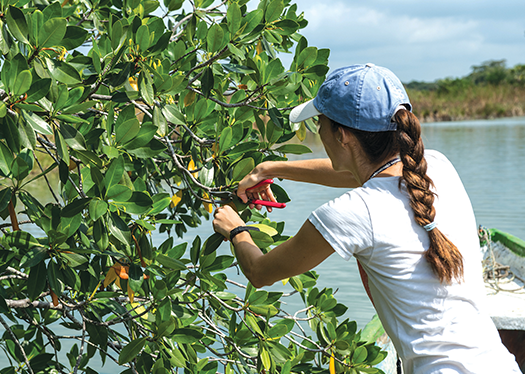
Project scientist Paula Ezcurra collecting an herbarium specimen from a red mangrove tree along the San Pedro Mártir River in the state of Tabasco, Mexico. (Photo by Ben Messiner)
Mexican botanist Carlos Manuel Burelo-Ramos fondly remembers fishing with his father in the San Pedro Mártir River, which winds through the tropical rainforests of the western portion of the Yucatán Peninsula. Years later as a professor and researcher at the Universidad Juárez Autónoma de Tabasco, his longstanding curiosity about red mangroves that began with those trips led him to a discovery that could yield fruit for climate science.
The San Pedro Mártir River flows from the Petén rainforests in Guatemala into Burelo-Ramos’s home region of Balancán, in the Mexican state of Tabasco, where it drains into the Gulf of Mexico. Between El Petén and Tabasco’s Reforma Waterfall—well inland of the Gulf—intermittent swaths of red-mangrove (Rhizophora mangle) can be seen on the banks, with their characteristic yellow flowers and fruit hanging in pods.
Burelo-Ramos became interested in red mangroves because they have the composition and appearance of coastal mangroves, but are located in a rainforest ecosystem 170 to 200 kilometers (105 to 124 miles) from the sea. Ecologists had studied the red mangroves for decades, but it was Burelo-Ramos who had the insight that the trees were vestiges of an earlier ecosystem, one originally located near the edge of the sea.
Since he started collecting plant species in inland areas along the San Pedro Mártir in 2015, Burelo-Ramos has identified a total of 112 species of plants that are usually found in coastal regions and 358 rainforest species that are typical of the region.
“It’s a combination of two ecosystems, one on top of the other,” he says. “We have a time capsule of mangrove surrounded by jungle. This mangrove forest is the world’s most inland mangrove forest recorded and possibly the highest, too.”
Though Burelo-Ramos hoped to research this natural superimposition further, he could not raise funding for the work in Mexico. So he invited Octavio Aburto-Oropeza, a marine biologist at the University of California, San Diego, to join him in the exploration. The two scientists assembled a team of seven experts, who published their research in October in the Proceedings of the National Academy of Sciences of the United States.
The team combined multiple lines of evidence and concluded that the red mangroves are a relict, a species that has effectively become stranded after surviving a long period of change that transformed the plant life around it.
Before that change began, temperatures had been warmer and sea levels had been six to nine meters higher than currently, meaning that at the time, the coastline was likely much closer. Currently, the red mangroves occupy an altitude ranging from 15 meters above sea level at Reforma Waterfall to 45 meters above sea level at the Mexican-Guatemalan border.
Burelo-Ramos and his colleagues aim to shed light on how climate change affects the world’s coastlines, a process that might allow them, for instance, to forecast how rising sea levels might affect the Yucatán Peninsula in the near future.
Team members integrated genomic, geological and floristic data with sea modeling. The conclusion was that this inland ecosystem established itself during the Last Interglacial (LIG) or Eemian Period, some 125,000 years ago. Temperatures were 3 or 4 degrees centigrade higher than they are today, and the ocean reached as far inland as the Reforma Waterfall, where some of the red mangroves of the San Pedro Mártir River live.
“The hypothesis is that a similar rise in sea levels would cover 30% of the Yucatán Peninsula. The path has already been marked out, and if we continue to live so irresponsibly, history will repeat itself and the ocean will wash over farmland and cities,” Burelo-Ramos says.
Coastal erosion is already a reality on the peninsula, where regular flooding and rising sea levels have forced communities to relocate. The region is considered one of the world’s most vulnerable to climate change. The Yucatán coastal cities of Cancún, Chetumal and Mérida are an average of 10 meters above sea level, as is Villahermosa—the capital of Tabasco state, where Burelo-Ramos lives.
“The San Pedro mangroves are warning us about the dramatic impact that climate change could have on the coastal plains of the Gulf of Mexico if we do not take urgent action to stop the emission of greenhouse gasses,” the research team said in a press statement announcing the publication of its findings.
It is not yet clear how the mangrove ecosystem persisted in isolation after the oceans eventually receded. Though they appear to have adapted to their current freshwater environment, their survival is far from guaranteed.
“This region was systematically deforested in the 1970s by a misguided development plan,” the scientists said in the press release, noting that the “the banks of the San Pedro River were spared because the bulldozers could not get in.” They added: “We hope our results convince the government of Tabasco and Mexico’s environmental authorities of the need to protect this ecosystem.”
Today, forest fires, slash-and-burn agriculture and deforestation have depleted red mangrove stands. Burelo-Ramos is adamant that reforestation of the species is essential to ensure the trees survive and continue to yield insights about their changing ecosystem.
“The story of Pleistocene glacial cycles is written in the DNA of [the red mangroves], waiting for scientists to decipher it,” he, Aburto-Oropeza and other members of their research team said in their press statement.
- Lara Rodríguez
In the index: A tall red mangrove provides habitat for various epiphytic cacti and orchid species, creating an ecosystem unique in the world. (Photo by Octavio Aburto)
For Proceedings of the National Academy of Sciences study: link